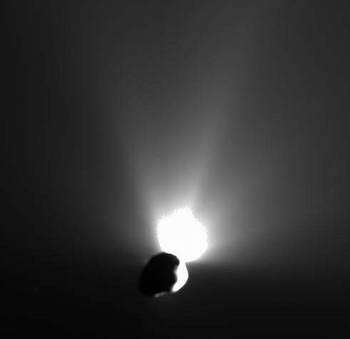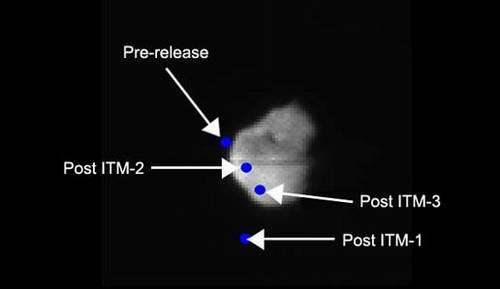Deep Impact Generates its Own Spectacular Photo Flash

The hyper-speed demise of NASA's Deep Impact probe generated an immense flash of light, which provided an excellent light source for the two cameras on the Deep Impact mothership. Deep Impact scientists theorize the 820-pound impactor vaporized deep below the comet's surface when the two collided at 1:52 am July 4, at a speed of about 10 kilometers per second (6.3 miles per second or 23,000 miles per hour).
Image: This image of Tempel 1 was taken by the high-resolution camera aboard Deep Impact's flyby spacecraft after the mission's impactor collided with the comet.
"You can not help but get a big flash when objects meet at 23,000 miles per hour," said Deep Impact co-investigator Dr. Pete Schultz of Brown University, Providence, R.I. "The heat produced by impact was at least several thousand degrees Kelvin and at that extreme temperature just about any material begins to glow. Essentially, we generated our own incandescent photo flash for less than a second."
The flash created by the impact was just one of the visual surprises that confronted the Deep Impact team. Preliminary assessment of the images and data downlinked from the flyby spacecraft have provided an amazing glimpse into the life of a comet.
"They say a picture can speak a thousand words," said Deep Impact Project Manager Rick Grammier of NASA's Jet Propulsion Laboratory, Pasadena, Calif. "But when you take a look at some of the ones we captured in the early morning hours of July 4, 2005 I think you can write a whole encyclopedia."
At a news conference held later on July 4, Deep Impact team members displayed a movie depicting the final moments of the impactor's life. The final image from the impactor was transmitted from the short-lived probe three seconds before it met its fiery end.
"The final image was taken from a distance of about 30 kilometers (18.6 miles) from the comet's surface," said Deep Impact Principal Investigator Dr. Michael A'Hearn of the University of Maryland, College Park. "From that close distance we can resolve features on the surface that are less than 4 meters (about 13 feet) across. When I signed on for this mission I wanted to get a close-up look at a comet, but this is ridiculous… in a great way."

Image: This image shows how Deep Impact's impactor targeted comet Tempel 1 as the spacecraft made its final approach in the early morning hours of July 4, Eastern time. The autonomous navigation system on the probe was designed to make as many as three impactor targeting maneuvers, identified as ITMs in this picture, to correct its course to the comet.
The upper left dot indicates where the probe would have passed the comet's nucleus if no maneuvers were performed. The dot below the nucleus shows where the probe would have flown past the comet if only the first maneuver was made. The leftmost dot on the nucleus marks the spot where the probe would have crunched the comet if only the first two maneuvers had been performed. The lower dot on the nucleus indicates the vicinity where, once the third maneuver was performed, the probe met its final reward and collided with the comet. Image credit: NASA/JPL-Caltech/UMD
The Deep Impact scientists are not the only ones taking a close look at their collected data. The mission's flight controller team is analyzing the impactor's final hours of flight. When the real-time telemetry came in after the impactor's first rocket firing, it showed the impactor moving away from the comet's path.
"It is fair to say we were monitoring the flight path of the impactor pretty closely," said Deep Impact navigator Shyam Bhaskaran of JPL. "Due to the flight software program, this initial maneuver moved us seven kilometers off course. This was not unexpected but at the same time not something we hoped to see. But then the second and third maneuvers put us right where we wanted to be."
The Deep Impact mission was implemented to provide a glimpse beneath the surface of a comet, where material from the solar system's formation remains relatively unchanged. Mission scientists hoped the project would answer basic questions about how the solar system formed, by providing an in-depth picture of the nature and composition of the frozen celestial travelers known as comets.
Source: NASA















